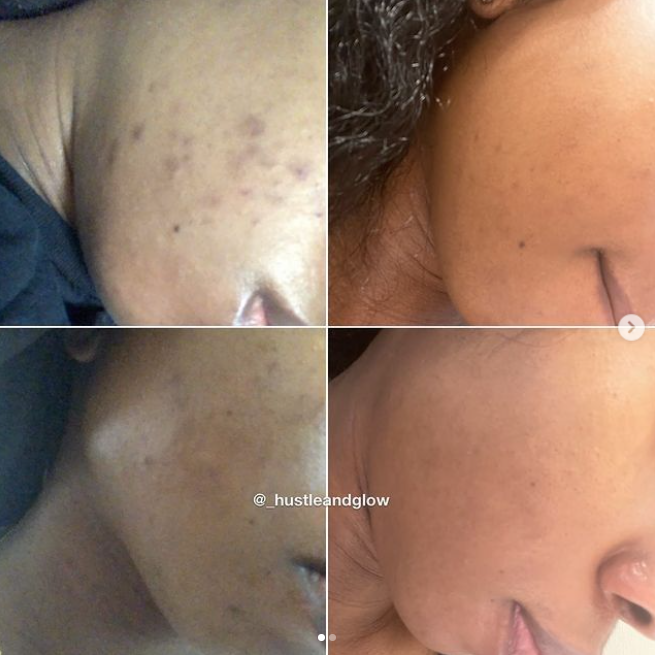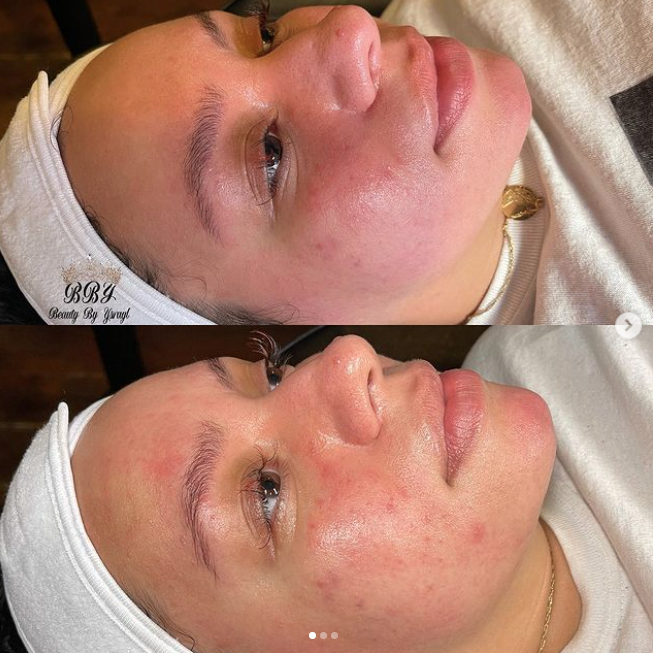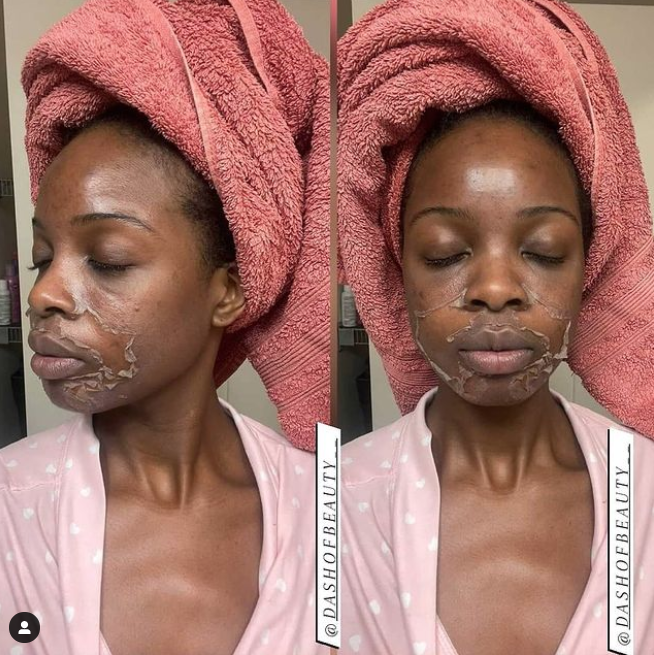Just the name “chemical peel” sounds a little scary, doesn’t it? Especially if you’ve ever seen the aftermath of an in-salon chemical peel treatment (hint for those who haven’t: it looks red, dry, and kind of uncomfortable).
However, at-home chemical peels are getting more and more popular for people looking to rejuvenate their face. They’re less harsh than the salon version but can still have amazing, transformative results.

How does a chemical peel work?
A chemical peel uses a concentration of acids and other chemicals – the amount and concentration will vary depending on the product and situation – to slough away dead skin. The chemical face peels that people have with their dermatologist uses a much stronger concentration of acids than the at-home versions do which means quicker and more dramatic results, but also an increased cost and risk.
There are three types of chemical peel: superficial, medium, and deep. Superficial peels are the mildest and common for an at-home peel, usually using something like glycolic acid. Medium chemical peels give a similar effect to a second-degree burn to the skin, usually by using a chemical like trichloracetic acid (TCA). Deep chemical peels are a dermatologist-only treatment that creates second-degree burns (a phenol peel is an example of this) and isn’t suitable for all skin types – they also need significant recovery time.
At-home versions of chemical peels can capture similar effects as a chemical peel with a dermatologist but on a smaller scale that’s safer than a medical-strength chemical peel in untrained hands.

Why do people use a chemical peel?
Most chemical peels are used as a method of deep exfoliation, using chemical solution rather than physical exfoliation particles like a scrub would use. Sometimes the pieces in facial scrubs can be too sharp and can actually damage the skin, causing micro-tears which can lead to irritation or even infection.
With this deep exfoliation in mind, there are a few different reasons that people use a chemical peel to improve their skin:
- Reduce fine lines and wrinkles
- Helps with uneven skin tone
- Increase brightness and glowing skin
- Helps with rough skin texture
- Lift any discoloration or dark spots
- Help to deal with acne
- Improve the appearance of scarring (such as acne scars)
- Unclog pores
- Improve the appearance of sun-damaged skin
Different acids in chemical peels are used as the solution for different issues – do your research and ensure that the ingredients in your chemical peel are right for your skin and any issues that you’re trying to solve.

Types of chemical peels
Here are some of the commonest types of chemical peels (from weakest to strongest), so you can start to decide which option could be right for you.
Superficial peels:
Enzyme peels
These are the lightest type of peel and are usually derived from fruit. It doesn’t work as an acid to increase cell turnover – it actually removes dead skin and refines your pores in a way that works for sensitive skin (and doesn’t make you more UV sensitive in the meantime).
Mandelic acid
Mandelic acid is used to improve fine lines, wrinkles, and uneven skin texture. It’s also great for acne and hyperpigmentation without causing irritation and redness. It works well with salicylic acid to gently exfoliate your skin.
Lactic acid
Lactic acid is known for smoothing, improving glow, and helping with minor wrinkles. It’s more hydrating than glycolic acid for hyperpigmentation and discoloration.
Salicylic acid
If you struggle with acne, salicylic acid is one of the best peels for treating it. It gets right into pores to dissolve congestion and blockages. It also doesn’t make your skin more sensitive to UV rays. Salicylic acid is great for hyperpigmentation and dark spots, sun damage, warts or skin build-up, fungal acne, and freckles.
Medium Peel:
Glycolic acid
The concentration of glycolic acid can vary, and it can actually fall into the “medium chemical peel” category. It increases the production of collagen, as well as working to improve texture, brightness, the appearance of wrinkles and/or acne scars and refreshes skin tone. It treats hyperpigmentation and acne too.
Jessner’s peel
This medium chemical peel contains salicylic acid, lactic acid, and resorcinol. It’s great for hyperpigmentation, acne, and oily skin but can make dry or sensitive skin even more so.
With a Jessner’s peel, it’s worth understanding that it will make parts of your skin turn white due to the exfoliation. It could take up to a week for you to feel comfortable after this peel.
Deep Peel:
TCA Deep chemical peel (trichloroacetic acid)
This is the strongest deep peel on this list and works well for sun damage, hyperpigmentation, wrinkles, fine lines, acne scars, and stretch marks. It will take around 7-10 days for your skin to start seeing the benefits.
Is an at-home chemical peel safe?
As we’ve already mentioned, at-home chemical peels use a lower concentration of acids which makes them less risky than trying to use medical-strength products. It makes sense to patch test the products on your skin before you go the whole hog on your entire face, just to check for any unnecessary irritation or reactions.
It’s also important not to over-exfoliate your skin as this can leave your skin inflamed, exposed, and with a compromised skin barrier. A damaged skin barrier can leave your skin feeling dry, right, and vulnerable to infections, sensitivity, and irritation.
You need to make sure that you use the right product for your skin, and seek advice before you try and if you aren’t sure or have sensitive/reactive skin.
What happens during an at-home chemical solution?
Read the instructions on your peel and apply as directed to freshly cleansed skin. You definitely need to only leave it on as long as instructed and follow instructions about what products to include or avoid alongside.
You might feel a mild tingling or stinging sensation as the product does its thing but it shouldn’t feel painful, burn or itch.
Post-peel aftercare
There are a few easy-to-follow aftercare rules once you’ve rinsed away your peel:
- SPF, SPF, SPF (at least SPF 30) – many peels will make your skin more photo-sensitive
- The redness should only last minutes after your peel – if it’s longer, seek advice
- Avoid some products afterward – retinoid cream, facials, and aggressive anti-aging products are a no following a chemical peel
Have you ever thought about or tried a chemical peel at home? Did you see the benefits and would you try it again? Let us know in the comments below!

FAQ:
What is a chemical peel good for?
Chemical peels can be used for a number of reasons, the most common include hyperpigmentation, anti-aging, and acne. Chemical peels are a great way to rejuvenate your skin, by removing dull surface cells and revealing younger-looking smoother skin.
Do chemical peels help with wrinkles?
Yes! Chemical peels improve the texture of the skin and help to reduce the appearance of fine lines. These peels can be used on all different types of skin including oily, dry, and combination as well.
How long do chemical peels last?
Chemical peels are meant to be a recurring treatment as they rejuvenate your skin after each time and make it look healthier, brighter, and younger. It is not recommended that you use them more than once a month.
How long is recovery from a chemical peel?
Recovery time will vary depending on the type of chemical peel used. If you have purchased an at-home system like Tend Skin to help your skin recover quicker, then this can help minimize scabbing, inflammation, and redness.
Do chemical peels hurt?
Chemical peels are different for each individual. Some feel nothing during the treatment while others may feel a bit of stinging or pinching in certain areas on their skin. A numbing cream can be applied to dull any potential pain that may occur during the process.
Can everybody get a chemical peel done?
Chemical peels are meant to be used on all different types of skin. However, you should never use any type of chemical peel if you have sensitive skin or are prone to cold sores.
What is the difference between glycolic acid and salicylic acid in chemical peels?
Glycolic acid is a naturally occurring alpha-hydroxy acid (AHA) that has smaller molecules that penetrate the skin easily, helping to dissolve dead surface cells and encourage cell turnover to help brighten up your skin tone. Salicylic acid is also an AHA but works by dissolving oil from the pores to keep them clear and prevent clogged pores.
What is the difference between home chemical peels and salon chemical peels?
Chemical peel treatments vary depending on the treatment used. A professional skincare specialist will know exactly what type of chemical peel to use for your particular skin type. Other factors that affect a chemical peel procedure are strength, depth of penetration, and concentration of the solution. When comparing salon treatments to home care, you should always opt for a professional treatment performed by a skin specialist.
How long does it take before you see results from chemical peels?
The level of improvement may vary depending on the condition of your skin before the treatment and what type of chemical peel was used. It can take up to eight weeks for you to see the full results of a chemical peel.
How long do chemical peels last?
Chemical peels usually last between five and twelve days. The amount of time will depend on what type of chemical peel was used and how your skin reacts after the treatment. How often these treatments are needed also varies depending on your skin type and how healthy it is.
What is an at-home chemical peel good for?
At-home chemical peels can be a great alternative to salon treatments due to their convenience and relatively low cost, but they are not as effective or powerful as a professional treatment done by a skin specialist.
How long after a chemical peel before you can go back to work?
Depending on what type of chemical peel was performed, the time it takes for your skin to recover will vary. Usually, you can return to regular activities like going back to work or school within one week after having a chemical peel done.
What is an enzyme peel?
An enzyme peel is a very mild form of chemical peel which is performed by applying an enzyme solution to your skin and letting it absorb for approximately 30 minutes.
What types of chemical peels can you do at home?
At-home chemical peels are available in over-the-counter kits that consist of different types such as fruit acids, glycolic acid, or salicylic acid. You can also opt for a do-it-yourself chemical peel by mixing baking soda with water and applying it to your skin.
When can you see results from chemical peels?
Depending on what types of chemical peels are used, there may be some immediate or visible results such as decreased acne breakouts, oil production, and improved tone.
Is it safe to get a chemical peel done by a professional at a salon?
Yes, your skincare specialist will know exactly what type of chemical peel is best for your skin type.
How long does the recovery process take after getting a chemical peel done?
The timing and length of time it takes to recover from chemical peels can vary depending on what type was used. You should be able to return to your regular activities after one week but you will have some mild redness or peeling of the skin during this time which can easily be covered with makeup.
Can chemical peels cause hyperpigmentation?
Chemical peel treatments can cause increased pigmentation in darker skin tones, but this is typically temporary.
How long does a chemical peel take?
The time it takes for a chemical peel to be performed depends on what type is used and your skin's reaction to the treatment. A typical professional facial with a light chemical peel will last an hour or less, while more intense treatments like deep peels with acids can last 2-3 hours.
What is a lactic acid peel?
A lactic acid peel is a chemical facial peel that applies lactic acid to your skin to remove dead and dry layers for smoother, healthier-looking skin.
How long do the side effects from chemical peels last?
The length of time it takes for the side effects of chemical peels to disappear will vary depending on what type was used and your skin's reaction to it. Some side effects can last up to two weeks in more severe treatments, but some mild peeling or redness may appear after only a day that can easily be covered with makeup for up to a week.
What is the difference between a chemical peel and a microdermabrasion?
The main difference between the two is that a chemical peel removes layers of skin with an acid solution, while microdermabrasion uses a diamond-tipped wand to remove dead layers.
How much does a full chemical peel treatment cost?
Chemical peels can vary based on what type you need to be done and where you get the treatment. Prices for chemical peels at a salon or spa will typically start around $100.00 and go up to $3,000.
What is a light chemical peel?
A light chemical peel focuses on removing dead skin cells from the outermost layers of your skin using fruit enzyme acids, glycolic acid, or salicylic acid as well as other ingredients.
What is a deep chemical peel?
A deep chemical peel is much more intensive than light peels and requires additional steps such as neutralization to stop the acid from working, followed by a hydrating mask or cream.





